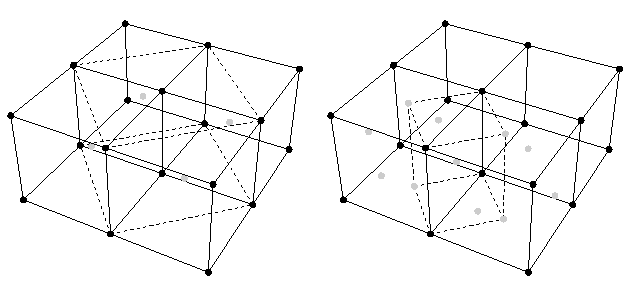
The cubic-to-tetragonal transition is described by two parameters, two unequal stretches along two mutually perpendicular directions.
Some alloys undergoing this transition are
There are several possible transitions between a cubic Bravais lattice and a tetragonal Bravais lattice:

Figure 1: Left: FCT lattice in a BCC lattice. Right: BCT lattice in a FCC lattice.
The transformation stretch matrices are the gradient of the deformations which take a cubic lattice into a tetragonal lattice. There are 3 such matrices, one for each variant of the martensite phase. They have components

The transformation stretches  and
and  are
proportional to
are
proportional to  ~
a/ao and c/ao, where a and
c are the lattice parameters of the tetragonal lattice and
ao is the lattice parameter of the cubic lattice.
~
a/ao and c/ao, where a and
c are the lattice parameters of the tetragonal lattice and
ao is the lattice parameter of the cubic lattice.
Here are links to various pages, where a number of different microstructures are discussed. Also contained therein is a table showing the possible microstructures for the cubic-to-tetragonal transition.
Some references are
``Fine phase mixtures as minimizers of energy.'' by John M. Ball and Richard D. James. Archive for Rational Mechanics and Analysis 100, 13 (1987).
``Proposed experimental tests of a theory of fine microstructure and the two-well problem.'' by John M. Ball and Richard D. James. Philosophical Transactions of the Royal Society of London A 338, 389 (1992).
``Wedge-like microstructure in martensites.'' by Kaushik Bhattacharya. Acta Metallurgica et Materialia 39, 2431 (1991).
``Symmetry and microstructure in martensites.'' by Kevin F. Hane and Thomas W. Shield. Philosophical Magazine A, 78, 1512 (1998).
``A microstructure of martensite which is not a minimizer of energy: the X-interface.'' by Guy Ruddock. Archive for Rational Mechanics and Analysis 127, 1 (1994).
Top of this page.
Back to main page.